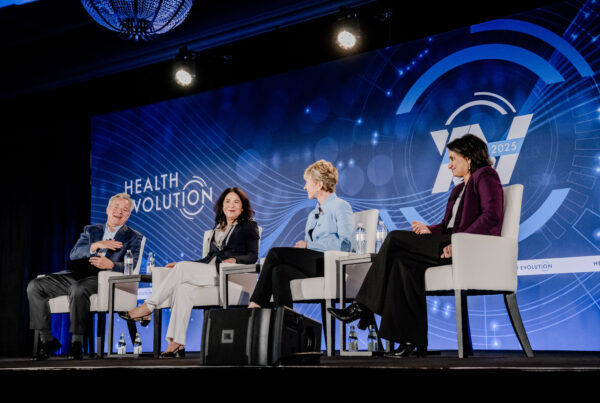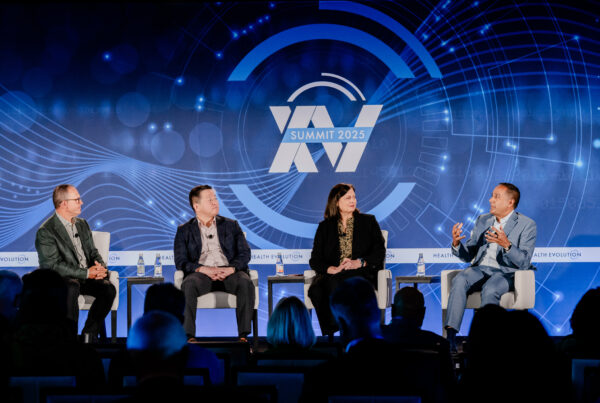It’s not hard to find a health executive that’s excited about AI.
Health Evolution’s own data shows that 89 percent of providers and 88 percent of payers plan on investing in AI and machine learning in the next three years. Moreover, investors poured $4 billion into health care AI startups in 2019 alone. Enthusiasm. Hype. Whatever you want to call it — it’s there. It’s palpable.
What’s harder to find are executives at organizations already actively using AI beyond pilot testing. Providence St. Joseph Health, a Catholic system that spans six states in the Northwest, is one of the few that have put significant financing behind its AI ambitions. The health system created Providence Ventures, a $300 million VC and growth equity fund to advance AI, digital health and innovation.
Aaron Martin, Providence Ventures’ Managing General Partner, who also serves as Providence St. Joseph Executive Vice President and Chief Digital Innovation Officer, sees the early impact of AI in consumerism, clinical, administrative and numerous other areas.
Martin and Maryam Gholami, chief product officer of digital innovations at Providence St. Joseph, spoke with Health Evolution about what they’ve discovered already and how they work with big tech and other AI partners.
Health Evolution: Why is AI such a big priority for Providence St. Joseph moving into the 2020s?
Aaron Martin: AI can help in voice scribing for physicians, getting them away from the EMR back to the joy of practicing medicine, and automate horrible repetitive tasks in the revenue cycle. [Gholami] is working on some cool stuff building a navigation/engagement layer using specialty bots so that the consumer who engages with us doesn’t notice we’re using different bots. We’re not repeating the dysfunctions of the health system offline. Our goal wasn’t to repeat how you engage with the health system offline and put it online — where they don’t know who you are or any context about you. What [Gholami] and her team are building is this notion that sits on top of these specialty bots around diagnose and treat, around navigation, around FAQ. There is automation in our call centers. There’s the multi-channel aspect of it, where you should be able to engage our health system through smart speakers. In a HIPAA-secure way, we built something with Amazon where you can schedule through Alexa. To say AI is important — I can talk about that for literally two hours.
Health Evolution: What are the biggest opportunities you see when it comes to AI?
Martin: The patient relationship. I’m biased and believe the biggest opportunity is an AI interaction with the patient to navigate the health system, help with diagnoses, help set up an appointment. All these interactions between the patient and health system, you can use AI to be more efficient. Once you get into the clinic, keeping the physician’s eyes on the patient rather than the EMR. Those are the two areas that are big and important in my opinion.
My counterpart BJ Moore [Providence St. Joseph CIO] would say there is a lot of interest in how you process data more effectively. One use case is the fact that most of the data in the EMR isn’t useful right now without a human going through it and looking at the clinical notes and trying to dissect useful information. So you can use machines that parse that information more efficiently. Amazon has made strides in that.
Maryam Gholami: A framework is important. When people think about AI, they think about it as a technology. At our organization, we have a framework where we look at each kind of task or areas where we want to put AI. We ask the question, is this task dull for humans? Can it be automated? For example, patient intake and registration. Documentation. These are some of the areas we consider dull tasks.
We also look at areas where human hands should not be involved. For example, if your hands are busy with surgery, how can we bring voice technology into the picture to help with task completion. We’re using AI to make sure the clinician isn’t touching everything during surgery to address concerns around hygiene.
If you think about EMRs, there is a lot of good, unstructured data that’s not being used today. That’s the area of natural language processing. We’re hoping to get that information into the cloud and start figuring out how we can leverage it for automation, population health management or insights. Those areas, as we look at our partnership with Microsoft, are the places we look to explore.
What’s happening in the industry and something we have to be careful about … people talk about AI&ML and worry about replacing humans. For us, it’s about augmenting humans. Putting humans where they do best and putting machines where they do best. We think about a 3-A formula. Do we want to assist the human? Do we want to augment the human? Or do we think this should be completely autonomous?
As we look at these technologies, we ask how much bias has been baked into them? We ask [startup companies and AI vendors] how did you come up with this? What data did you use? Depending on what AI&ML technology they use, they could introduce bias from the data. They could introduce bias from the expert that modeled and tuned this algorithm. So we not only look at where the AI technology could be used, but is the technology biased? Is it ethical for us to introduce to the patient?
Health Evolution: You mentioned Microsoft. What is the importance to strategic partnerships in this space?
Martin: Microsoft is our cloud partner from a storage and computing standpoint. But any organization is not going to be exclusive with a specific partner. They are going to have to work in a multi-cloud environment. Storage and computing are commoditized. There’s a pricing war. We’re the beneficiaries as customers, but that’s not where the innovation is any more. The innovation is how they can lower costs.
Innovation is what’s on those clouds and what’s available by partnering with those organizations. It’s the AI and algorithms that are hosted on those clouds. If you want access to that technology to solve these problems, you have to be in a multi-cloud environment. There is some overlap, but each of these organizations are not working on the exact same problems with the exact same algorithms. You need to access multiple clouds.
Gholami: There are technologies we believe are early and when we built this framework, we built it in a way that at the end of the day, we’re picking the best options for patients. We are ready to engage with a company that does the technology the best. Sometimes that’s Microsoft. Sometimes that’s Amazon. Sometimes that’s a startup. We keep an eye on all these companies who are competing on some of these early technologies. We’re open to all of them.










